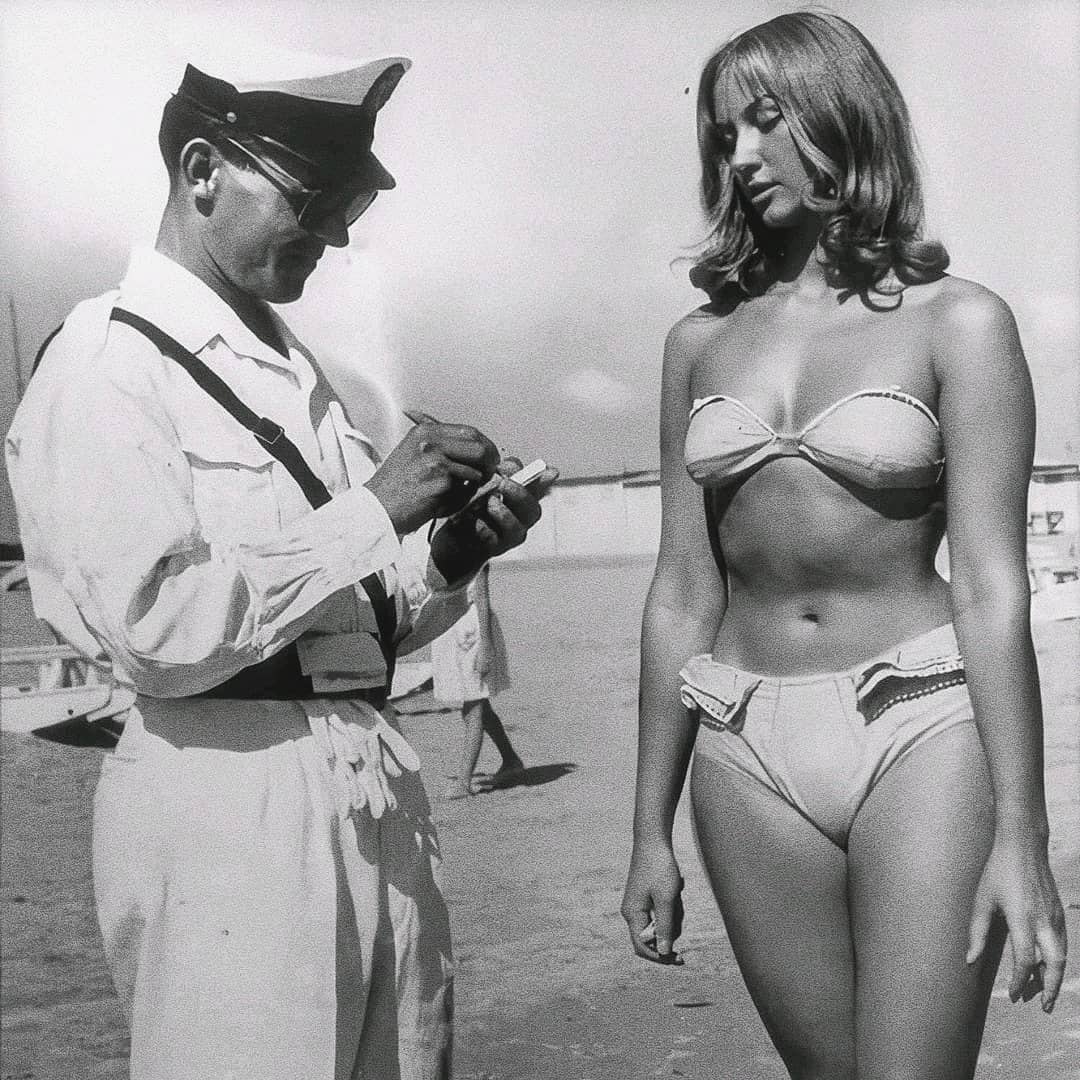One small piece of clothing. That was all that was required to provoke worldwide indignation, prohibitions, and even arrests.
The bikini was both the antagonist and the winner in the decades-long struggle between freedom and modesty. It was deemed wicked by popes. The governments banned it.
However, ladies continued to wear it, changing the rules with each daring look.
Beachside tailors
The sleek, fashionable swimwear designs of the early 20th century were very different from those of today. In the past, they were large, full-body, wool clothing items used to shield swimmers from the sun. This was about modesty, not about style.
Beaches all around the United States had strict clothing regulations. In their book on 1920s pop culture, Kathleen Morgan Drowne and Patrick Huber claim that locations such as Chicago’s Clarendon Beach even employed tailors to make last-minute modifications to swimwear that was judged to be overly exposing.
Similar regulations appeared all around the country; in 1915, Coney Island, for instance, outlawed swimming socks that revealed “dimpled knees.” Beach police in Washington, DC, were known to use tape measures to enforce these laws.
Got a one-piece arrest?
The focus of the early 1900s was concealment. There was no exception to the rule that both men and women should dress in neck-to-knee suits. Was there any exposed skin? That was deemed scandalous, anyway.
But things were about to change. One of the first people to defy these conventions was the Australian swimmer Annette Kellerman, who in 1907 chose to forgo the then-accepted pantaloons in favor of a one-piece suit that exposed her arms, legs, and neck.
Kellerman, known as “the Australian Mermaid” due to her exceptional swimming abilities, dedicated a significant portion of her life to questioning social conventions and redefining values.

Although there are no official reports to support it, Kellerman claims that she was arrested by the police for wearing her “indecent” attire. At the time, however, it was scandalous for a lady to swim like that. The event generated a movement and made news.
The audience was drawn to Kellerman’s bold swimsuit selection, and her one-piece suits quickly gained popularity.
She subsequently started her own swimwear line because of the overwhelming demand, and the so-called “Annette Kellermans” were the first to contribute to the development of contemporary women’s swimwear.
The Roaring Twenties: A New Fashion Trend
As the 1920s raged on, the flapper look began to gain popularity at the beach as well as in evening attire.
It all began when a bunch of Californian rebels defied convention. The “skirts be hanged girls” had the straightforward but revolutionary goal of creating swimwear that women could actually wear.
Swimwear started to change as a result, becoming more form-fitting and functional. The “skirts be hanged girls” represented a national movement that prioritized practicality and mobility over merely style.
Women were gradually exposing more skin, even if it was still modest by today’s standards, thanks to swimwear that allowed for greater mobility. However, the real revolution had not yet occurred.
The bikini: An outrageous advancement
Then 1946 arrived, and the bikini was born. This two-piece swimsuit, created by French engineer Louis Réard, showed off more skin than anyone believed was suitable for public areas and exposed the navel.
The U.S. conducted its first nuclear test in peacetime at Bikini Atoll, garnering international attention just days before the bikini was launched in 1946.
Designer Louis Réard never gave an explanation for his choice of the word “bikini,” but many people think it was a reference to the bomb-like impact he anticipated the swimsuit would have, both commercially and culturally. Others claim the moniker recalled the Pacific’s exotic charm or likened the might of an atomic bomb to the shock of a skimpy bikini.

In the United States, the response was swift: the bikini was deemed to be blatantly rebellious and was prohibited from numerous beaches. In Europe, things weren’t any simpler either. Bikinis were outlawed on French beaches in 1949, and they were not allowed in German public pools until the 1970s. Meanwhile, some communist organizations denounced the bikini as an example of moral decay and capitalist degradation.
Following Pope Pius XII’s declaration that the bikini is evil, various nations, including Belgium, Italy, Portugal, and Spain, imposed statewide swimsuit bans.
Australian model Ann Ferguson was forced to leave Surfers Paradise’s beach in 1952 when it was deemed that her Paula Stafford bikini was too exposing.
The truth regarding the well-known picture
A single image has come to represent the entire controversy around the appropriateness of bikinis on public beaches. It is also Italian.
A man in a white uniform is seen standing next to a young woman in a bikini on a beach in this black-and-white photo that has gone viral in recent years. People on social media frequently assert that the scene was caught in 1957 in Rimini, Italy. According to the story’s most popular version, the woman is given a ticket by the male, who is a police officer, for simply wearing a bikini.
The image was included in a 2023 Reddit post that received 1,400 comments and more than 31,000 upvotes. “A police officer issues a ticket to a woman for wearing a bikini, 1957” was the caption.

Was it real, though?
The backstory is still unknown, but the shot itself is real—there is no indication of computer manipulation. There is no concrete evidence that the woman’s swimsuit earned her a ticket. Some others think the officer might have been mentioning her for a whole different cause, while others think it might have been a manufactured situation with actors or models.
Nevertheless, the picture touched a nerve.
Even while the photo’s backstory is still unknown, Gianluca Braschi, director of the State Archives of Rimini, confirmed to Snopes via email that swimsuit restrictions were in effect in Italy at the time.
According to Braschi, “bathing in public view in a state of complete nudity and with indecent swimwear” was prohibited by law in 1932.Technically, that law was still in effect until 2000, but its application was patchy.
Therefore, even if the whole story behind that viral moment may never be known, it captures a very real tension from the time period where bikinis weren’t simply eye-catching. They might also land you in hot water.
The impact of Hollywood
The bikini did not truly gain popularity until the 1960s. More provocative swimwear fashions were made possible by cultural changes.
Even yet, there were differences in public opinion. The small two-piece was repelled by more conservative regions.
One such is the Hays Code, also known as the United States Motion Picture Production Code, which went into effect in 1934. It forbade the display of the navel in movies, although it permitted two-piece attire. The National Legion of Decency, a Roman Catholic watchdog organization, increased the pressure by urging Hollywood and foreign filmmakers to completely ban bikinis on the big screen.
The emergence of Hollywood celebrities such as Brigitte Bardot, Ursula Andress, and Marilyn Monroe contributed to a redefining of the ideals of body confidence and beauty. Not only did these icons don swimwear, they came to represent them.
The Bikini-Wearing Girl
The French actress Brigitte Bardot may have done more than anybody else to bring the bikini to the attention of the world.
She owned her bikini, not just the fact that she wore one. Bardot transformed the swimsuit into a cultural statement in her breakthrough performance in The Girl in the Bikini. The film’s focal point was her physique, poured into a diamond-shaped, strapless bikini top that seemed like it would give way at any second.
Bardot was changing the norms of how women may be portrayed on cinema with her long, disheveled hair and easygoing demeanor.
Although the film made sure to depict her in balance with the sun and the ocean, let’s face it—the camera loved her physique. Despite being framed in the traditional pin-up fashion, Bardot was more than simply a pretty face; she was the first actress to feature a bikini in a major part and give it a storyline.

Although she wasn’t the first woman to wear one, Bardot was the first to use storytelling to make the bikini iconic, and the success of that movie in the United States catapulted her into immediate international stardom.
Because it brought together sex appeal, strength, and cinematic impact in a way that had never been seen before, Ursula Andress’s white bikini from Dr. No (1962) instantly became an icon.
Andress was more than simply a stunning sight when she came out of the water with a knife strapped to her hip; she was strong, confident, and unforgettable. The incident solidified the bikini as a representation of fearless femininity in popular culture and established her as the quintessential Bond girl.
The bikini was popular by the 1970s. With the introduction of string bikinis and thong-style bottoms, swimwear became even more exposing. As the “modesty” of the early 20th century faded, men’s swim trunks also became smaller.
Today’s swimwear: diversity and body positivity
In the twenty-first century, wearing swimwear is about more than just following social conventions. The market for swimwear has grown rapidly, creating a vast array of options.
There is something for everyone, ranging from bold thongs to string bikinis and understated one-pieces. Furthermore, the discussion of body kinds has changed dramatically. Nowadays, people of all shapes, sizes, and backgrounds freely express themselves at the beach or pool, demonstrating ease, confidence, and body positivity.
The days of policing “decent” swimwear are long gone. Nowadays, it all comes down to individual preference and self-expression. America’s evolving attitudes toward modesty, whether it be the most showing bikini or a full-coverage swimsuit, represent a society that is far more welcoming and inclusive.
The fight for modesty has transformed into a celebration of freedom, uniqueness, and diversity. The road to self-expression that the swimsuit symbolizes is more important than the swimsuit itself, so keep that in mind the next time you visit the beach.


